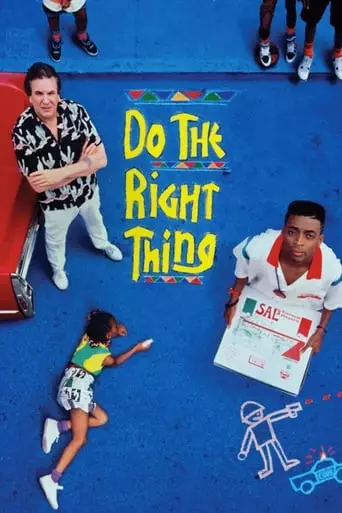
Salvatore “Sal” Fragione is the Italian owner of a pizzeria in Brooklyn. A neighborhood local, Buggin’ Out, becomes upset when he sees that the pizzeria’s Wall of Fame exhibits only Italian actors. Buggin’ Out believes a pizzeria in a black neighborhood should showcase black actors, but Sal disagrees. The wall becomes a symbol of racism and hate to Buggin’ Out and to other people in the neighborhood, and tensions rise.
Directed by Spike Lee, Do the Right Thing is set on the hottest day of the summer in the Bedford-Stuyvesant neighborhood of Brooklyn, New York. The story primarily revolves around Mookie (played by Spike Lee), a young African American who works as a pizza delivery man for Sal’s Pizzeria, owned by the Italian-American Sal (Danny Aiello). Sal is proud of his pizzeria but comes into conflict with the local black community when Radio Raheem (Bill Nunn) and Buggin’ Out (Giancarlo Esposito) demand that black faces be represented on Sal’s “Wall of Fame,” which is filled with images of famous Italians.
The tension escalates when Sal’s sons, Pino (John Turturro) and Vito (Richard Edson), add fuel to the fire, and an altercation leads to the tragic death of Radio Raheem at the hands of the police. The death sparks a riot, which ends with the destruction of Sal’s Pizzeria. Mookie, the film’s central character, must navigate the complex moral and social issues surrounding race, justice, and community.
The movie explores deep and complex themes of race, identity, community, and justice. The racial tension in the neighborhood builds throughout the film, symbolized by the oppressive summer heat. This heat mirrors the growing animosity between the residents and Sal’s family. As the day progresses, the conflict intensifies, showing how longstanding racial prejudices and social inequalities can lead to violence and destruction.
Spike Lee uses the characters to represent different societal viewpoints. Sal and his family represent the immigrant experience, often caught between assimilation and their roots, while the African American characters, like Mookie and Radio Raheem, are caught in a struggle for recognition and justice. The police brutality that leads to the death of Radio Raheem highlights the systemic racism that disproportionately affects black people.
Lee’s direction ensures that each character’s actions and choices resonate with the broader social and political issues of the time. The film’s vivid use of color, cinematography, and sound, including Public Enemy’s “Fight the Power,” enhances the emotional impact of these themes. The non-linear structure and the way Lee interweaves various subplots highlight the complexity of social dynamics in urban America.
After watching Do the Right Thing, you may feel a sense of discomfort and emotional unrest. The film’s portrayal of racial violence and systemic injustice is powerful, leaving a lasting impact on viewers. The unresolved nature of the film’s ending—where no clear resolution to the racial conflict is offered—forces the audience to confront the harsh realities of discrimination and the complexities of doing the “right” thing in a divided society.
The film challenges the viewer to reflect on their own beliefs about race, justice, and the choices people make in times of tension. You may feel anger, frustration, or even guilt, particularly after witnessing the brutal killing of Radio Raheem by the police. The movie will likely leave you questioning how far things have come since its release in 1989, and how much work still needs to be done in addressing racial inequalities in contemporary society
